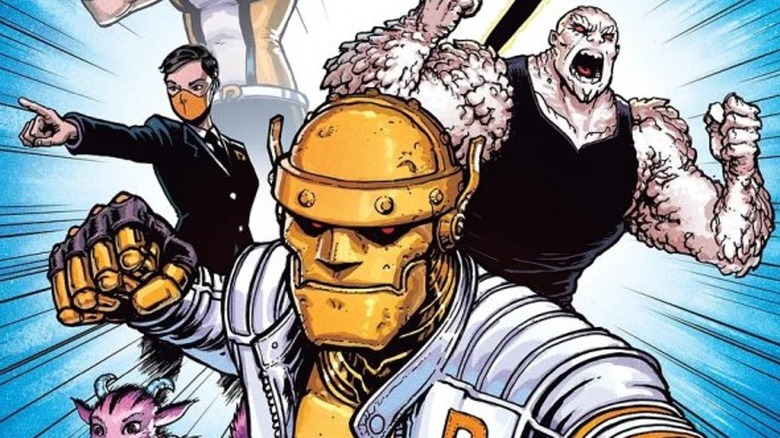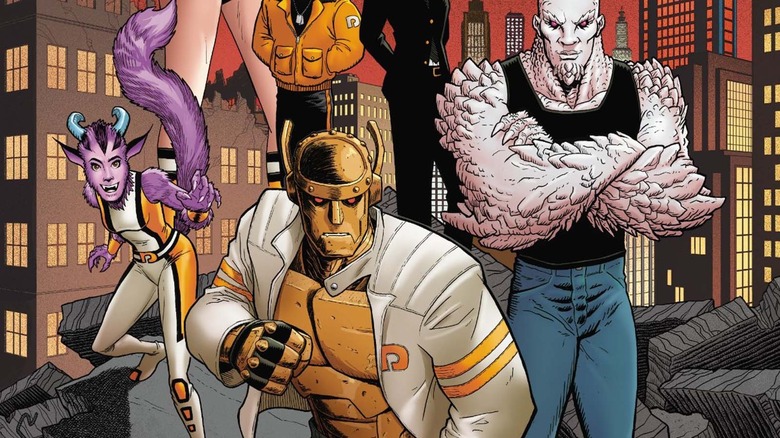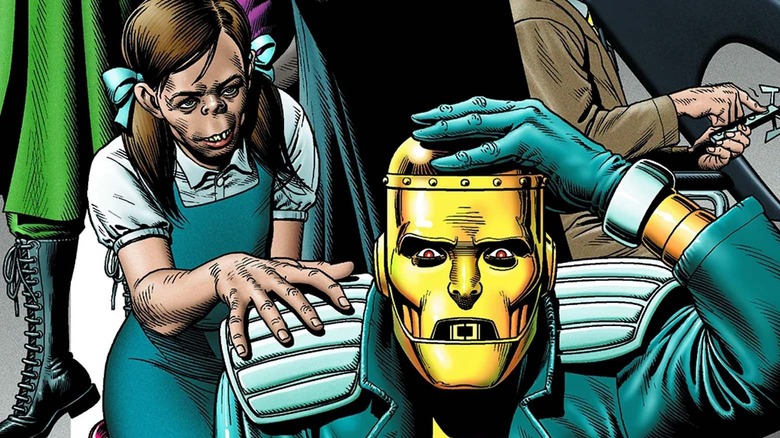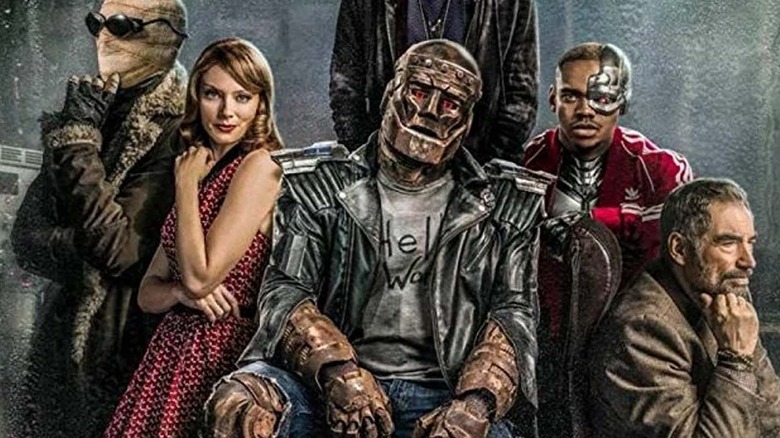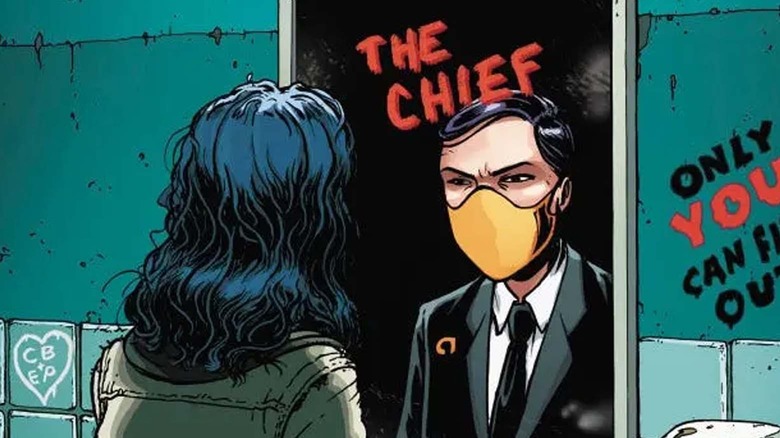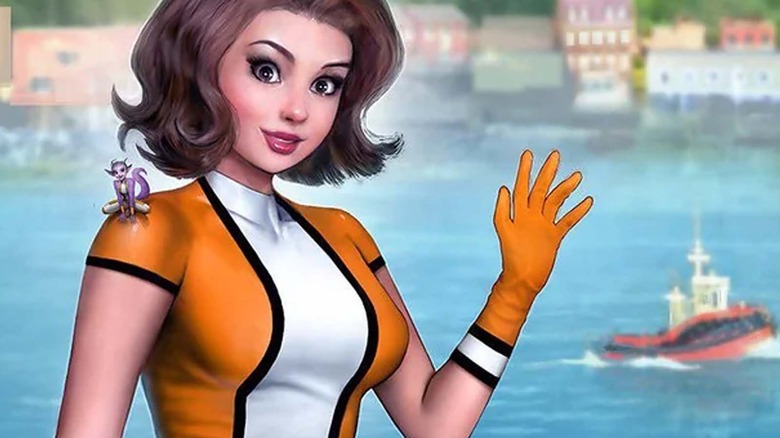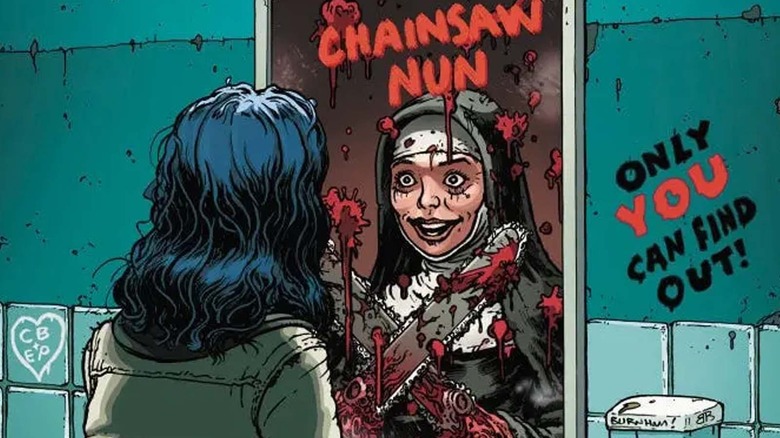Dennis Culver And Chris Burnham On Bringing Back DC's Doom Patrol - Exclusive Interview
The Doom Patrol are back in the pages of DC Comics as some fan-favorite members of the classic superteam are joined by a couple of newcomers in "Unstoppable Doom Patrol," which arrives in comic book shops on March 28.
The new run will spin out of the events of "Lazarus Planet" as the Doom Patrol find themselves trying to save recently transformed metahumans. For the Doom Patrol, their mission is an extremely personal one, as they're all too familiar with going through being changed against their will. However, while Robotman, Elasti-Woman, and Negative Man are part of the new roster, it will feature an expanded cast of heroes, including Beast Girl and Degenerate. Meanwhile, Crazy Jane is taking on an all-new [alter], throwing a wrench into the usual dynamic of the Doom Patrol.
We got the chance to speak to writer Dennis Culver and artist Chris Burnham about introducing a new "Doom Patrol" team, drawing inspiration from the show, and introducing new heroes.
The origins of Unstoppable Doom Patrol
How did this project come to be, and what made Chris [Burnham] the perfect artist for it?
Dennis Culver: I was talking to my editor, Ben Abernathy, as I was wrapping up "Future State" and talking about what was next. Josh Williamson and I co-wrote "Justice League Incarnate," and we had Burnham on for a section of that. Burnham and I also used to be in a studio together before the pandemic for a number of years. We worked together on stuff before and we had that relationship going, and Ben was basically saying, "Whatever we do, you should do something with Burnham next." I was like, "That's a good idea. I love his art." Through the nature of our conversations, I was spitballing ideas, [and] I had an idea for a Robotman story that ends up being Issue 3.
That got me on a tangent with Ben talking about the Doom Patrol — not as any sort of pitch in my mind, but more of a rant: "Why don't they have a book? There's a TV show." I like that they're separate from all the Justice League family of characters. I was rambling, and Ben, in his wisdom, was like, "You and Burnham should do 'Doom Patrol.'" I was like, "That's a great idea."
I texted Burnham, and he was immediately [like], "Hell, yeah." If you know Burnham's art and his style, the stuff he loves to draw, "Doom Patrol" is a no-brainer for him. It's something I feel like he was made to do. Also, he loves drawing mummies.
It wasn't like DC decided one day, "We got to have a 'Doom Patrol' comic." It was all these pieces [fitting] together. Then, some cool coincidences started happening. One, the "Lazarus Planet" event was happening, and they were like, "It would be cool if you could plug it into that." I was like, "That's a great way to get more metahumans into things." Then, unbeknownst to us, this year's the 60th anniversary of the Doom Patrol. That's great timing.
As we were getting everything together, the "Dawn of DC" initiative was coming together as "Dark Crisis" wrapped up. It was great. We got to be right at the forefront of that. We already had art in the can; we were ready to go. A lot of really cool, fortunate things have happened as we've been putting this series together. I like to think of it as all good signs pointing to yes for us.
What attracted you to this project, Chris?
Chris Burnham: I love drawing this sort of thing. I love drawing human anguish. I love drawing miserable people or agony and pain. The team is mostly monsters, and monsters are way more fun to draw than pretty people. [...] The mix of action, human drama, body horror, and science fiction [is] great. And mummies, of course — my first love is mummies.
Following up on Doom Patrol's history
"Doom Patrol" has had a storied history despite not always being around in DC Comics, from Grant Morrison and Richard Case to Rachel Pollack, Arnold Drake, and Gerard Way. What was it like to follow those runs? Were you inspired by those books?
Culver: I reread everything, and I'm also a big fan of all your comics count. In my mind, all of these issues of "Doom Patrol" [are] part of the big tapestry of their continuity. It may not hang together perfectly, but it all happens somehow in some way. We don't have to worry about that too much as we're moving forward, but if you're a lifelong fan of "Doom Patrol" like me, you're going to find a lot of cool little Easter eggs and stuff in there that's going to make you really happy. If you're just jumping in with the "Dawn of DC" initiative, it's a good jumping-on point, and we'll make sure that [you know] everything that you need to know as you go.
I was reading the Grant Morrison stuff in high school, so it was warping my developing brain. I got in early and started going backward and forward, following all the "Doom Patrol" runs and locating issues and anything I could to read it. The internet makes it way easier now, but it's more fun digging around looking for stuff.
There's a neat history there. If you follow the thread of those characters — how they're healing and dealing with their trauma — once we get to the end of the Gerard Way run, they've gotten their s*** together. There's still work to do, but when you get your s*** together, when you've healed from trauma, it's a natural instinct to want to help people. That dovetails nicely into our run, which is saving the world by saving the monsters.
Chris, what artists inspired you for this one?
Burnham: It's all so great. I read for the first time the [Arnold] Drake, [Bruno] Premiani stuff in prep for this, and it is awesome. As a modern reader, you have to get yourself into the 1960s zone to dig into the art, but I absolutely love it. It is beautiful, phenomenal work. I didn't know anything about it, so it was a surprise, issue after issue, the weird relationship with Mento and all the crazy stuff that happens — endlessly surprising stuff.
Nick Derington is amazing. We've got a similar sort of influence, so it's pretty easy to glom onto his designs a little bit.
Richard Case is amazing. I cannot understand how he was able to draw cathedrals made out of butterflies page after page, sometimes in runs for years on end. It's crazy the amount of stuff that he was able to accomplish on a regular basis; it's wild.
Eric Larson [is] one of my all-time favorite creators. "Savage Dragon" is basically the perfect comic ever, and he got his mainstream start with "Doom Patrol." It's cool to work in his legacy a little bit.
Seth Fisher drew two of his best comics in a John Arcudi-written run. There's fantastic art throughout the last 60 years or whatever.
Culver: "Doom Patrol" has a really good pedigree of creators. Hopefully, they'll feel the same about us once we get to it.
How Doom Patrol was inspired by the TV series
"Doom Patrol" has always been one of those sleeper cult favorites for a lot of people, but you guys were coming in following a live-action series, and the roster is pretty similar to that. Did you draw any inspiration from that?
Culver: I'm a huge fan of that show. As far as adaptation goes, it's great. It takes that Grant Morrison [and] Richard Case material and digs in deeper with it. That show has so much heart that I love. It's nothing but a benefit for us because now when you read our comic, you have these voices for the characters. As far as I'm concerned, it helps.
By design, I wanted it to look like the TV show felt. I didn't know at the time that we were developing it that the "Doom Patrol" TV show was coming to an end, but I knew it was coming back. I wanted it to smell like the same thing while it's not exactly the same thing, because it's a little more action-driven and stuff. But we definitely want fans of the show to check out the comic.
Even where the show's heading — again, speaking of fun coincidences — we didn't know what was coming up in that comic. It's funny that season [has] focused suddenly on Immortus. We've definitely got General Immortus in our run. [For] Issue 3, which is an issue where Cliff is on a road trip with Larry saving someone, it was always in my mind that he was going to have a muscle car, real "Fast & Furious" vibes. Then in that new season, they're going down the street, and they stumble across a muscle car. When [Chris Burnham] was doing that cover, I was like, "You might as well use this car as ref. You might as well match it up."
It's a lot of really neat things. We're definitely surfing the same brainwave when it comes to "Doom Patrol." Fans of the show and fans of the comics [are] going to love this book. Also, "Doom Patrol"'s never been firmly planted in the DC Universe like this. What makes that interesting to me as a writer is there's a lot of new territory that you wouldn't think would be available. [...] That's super fun to play with because we're getting to explore the DC universe with these characters who, over the 60 years, haven't spent a lot of time there.
Redesigning the Doom Patrol
How fun was it to redesign these characters? The new looks for the characters are still recognizable. What was that fine line of wanting to do something new but also keeping their original looks intact?
Culver: It's to Burnham's credit as an artist. He's good at getting the acting and the vibe. Even if you look at the subtle differences in the sizes ... I don't know how much thought Burnham put into that, but I know Burnham a lot of times does stuff on instinct, and it works perfectly.
Burnham: It's trying to figure out how to incorporate everything I like from all the different takes on it. [...] Whatever I like from each artist's interpretation that is going to work well with my style has found its way in. I noticed the other day the bolts on Robotman's forehead — some people draw this kind of headband. It almost looks like it's the Frankenstein pop off the top of his head. Some people lower it down so that it becomes his brow, like he's got a caveman, Ben Grimm-like brow. I like to go with the caveman brow. It helps him emote, and it's more fun for me to draw that way.
I love how no matter how specific the design is, everyone's got their own take on what it looks like, and then it's up to each artist to interpret how it works best for them. I imagine by the end of the series, I'll be trying it a little bit differently, finding how it happens to work with my wrist and fingers.
What was behind the decision to give Crazy Jane a new [alter] as the Chief and to introduce new characters?
Culver: I was trying to think about the iconic roles of the Doom Patrol — you've got the three core characters. I didn't feel like it was authentic to have Niles in charge of the team, given his history and what he's done to them. He caused the disasters that gave them their abilities, for the most part. It was like, "What if we had a new Chief?" I love Crazy Jane as a character, so it seemed like, "What if one of her alters was the Chief?" It all started coming to life right then and there. The same thing with ... The team's got to have a Beast Boy. It's like, "What if it's a Beast Girl?"
I did a cool little drawing of what I was thinking, and Burnham made it way better. Once Burnham started drawing Beast Girl, her personality emerged for me. You've got my core idea of the Doom Patrol with the three main characters, the Chief, and then you've got the Beast Girl character fulfilling that young-spunky-kid role.
Then I was like, "We've got to have a member that contrasts that, who's the d**k to tell them, 'You guys are messed up. Whatever you're doing here is wrong.'" That's where Degenerate evolved, which is giving us this counterpoint. The way his powers work, he has to actively choose to be mean. I call him a "D**k Hulk" — the meaner he is, the more he starts to devolve, and he can get out of control [...]
With the Chief's design, the only thing that I was zoomed in on was her having that orange mask to almost emulate Niles' beard. [...] Once we got the green light, we started developing it, and Burnham zeroed in on that. I sent a picture to him of a woman in a sharp business suit, and [we] went from there.
Connecting Doom Patrol to the greater DC Universe
Without going into spoilers, how does this book connect to the greater DC universe?
Culver: "Dawn of DC" kind of spun out of the end of "Dark Crisis." [At] the end of "Dark Crisis," there's that little stinger where Amanda Waller shows up, and she's been away from the main Earth for a while. She was on Earth-3 up to something, and now she's back and she's anti-superheroes in general. Then suddenly there's no more Justice League. The Justice League is disbanded in the wake of some of that stuff, and the Titans are rising to that role.
Then over here is this Doom Patrol, who's on their own mission, and they're suddenly pushing these new ideas at a time when someone like Waller and the rest of the world's government are tightening [up] on things. And here's the Doom Patrol saving the world by saving the monsters. They're taking these people to their new base. We call it the shelter. It's in an abandoned missile silo that's been converted into their base.
In the eyes of the powers that be in the government of the DC universe, that's a big powder keg, where they're bringing all of these metahumans that they consider weapons of mass destruction. So the Doom Patrol are butting up against some of the things that are happening in the DC universe behind the scenes, and that story is going to develop over the next year. The Doom Patrol is stepping on people's toes, not just nefarious government organizations, but also, they're mad at members of the Justice League because the Justice League has allowed things like Arkham Tower and the Suicide Squad to exist.
And the Suicide Squad is awful for metahumans. They make you a living weapon for the government, and they put a bomb in your head. It's something the Doom Patrol is diametrically opposed to. If there's one team that I think is the total opposite of the Doom Patrol, it's definitely the Suicide Squad because it's everything they're against. [...]
I hope [readers] get the book. That's what we want. Also, there's some neat stuff that we're doing with "Doom Patrol #1." In the first issue, we have a number of variant covers, and some of them are standard. One of them is a cool design variant that Darren, the DC designer, put together based on Burnham's character design sketches that are really cool. Also, we did a scratch-off variant.
Doom Patrol's unique variant covers
Culver: It was Burnham's obsession when we were in a studio together. Somebody came up to [him] at a show or something and showed [him] scratch-off covers, so Burnham would always talk about that. Then when we got the green light to do it, Burnham was like, "Maybe we can do a scratch-off." I was like, "I'll ask Ben. I don't know." And it happened to coincide [with] when we were at San Diego. Ben and I were having breakfast, and I was like, "Burnham's got a crazy idea. He wants to do a scratch-off cover. What do you think?" And Ben, to his credit, picked up his phone and started texting people to see if it was possible.
[Then] Burnham and I started talking about it. Now it's like, "What does this even look like to do a scratch-off cover? How is it meaningful for Doom Patrol?" Ben already had a glow-in-the-dark cover for Issue 2 that was focused on Larry, and I liked the idea that we could have variant covers that were a little more character-driven because [a] glow-in-the-dark cover makes sense for Negative Man. He's radioactive. [...]
It's like, "A scratch-off cover — what if they were like a lottery ticket [and] you don't know what result you're going to get? What if there were different results?" That's perfect for Crazy Jane, [with] all of her alternate identities. So I had a little sketch that I put together where we're behind Jane; she's standing at the mirror. I sent it to Burnham, and we back-and-forthed that. Then we pitched it to Ben: "Do you think we could have a couple of different options when you scratch it off?" Again, to his credit, he was like, "Let me see." At first, it was only going to be three. [Then] he's like, "Actually, can you guys do five?"
So then it was picking the identities. Once we had the big cover done, it was easy for Burnham to slot in those characters. It was a real, true collaborative process. He couldn't figure out how to write the lipstick on the mirror, so I did that for him.
Burnham: I was wasting all sorts of time. I've got the worst handwriting in the world.
Culver: It was really fun. It was all of us collaborating on a project. They did a test at the DC offices. Darren posted a picture where they scratched it off and it worked. I'm excited to see how [people] react to it. It tickles that part of the collector market where you want to keep one un-scratched and then can you catch them all. Hopefully it's popular and gets people interested in the comic too.
Burnham: The fact that it is 2023 and no one has ever done this in the history of comics as far as we can tell [is] super cool.
Culver: Yeah. There's only been one other. It was an IDW "G.I. Joe" comic, but it only had one outcome. It was like, "Who's the new Cobra Commander?" And you scratch off his faceplate, and it's whoever it was. But nobody's ever done multiple options, like a lottery scratch-off ticket. It's super cool, and because it feels character-driven, it's something that would get me excited as a reader. I'm super into it.
The Doom Patrol's next era begins when "Unstoppable Doom Patrol #1," by Dennis Culver and Chris Burnham, arrives in comic book stores on March 28. The series will run for six issues.
This interview has been edited for length and clarity.
